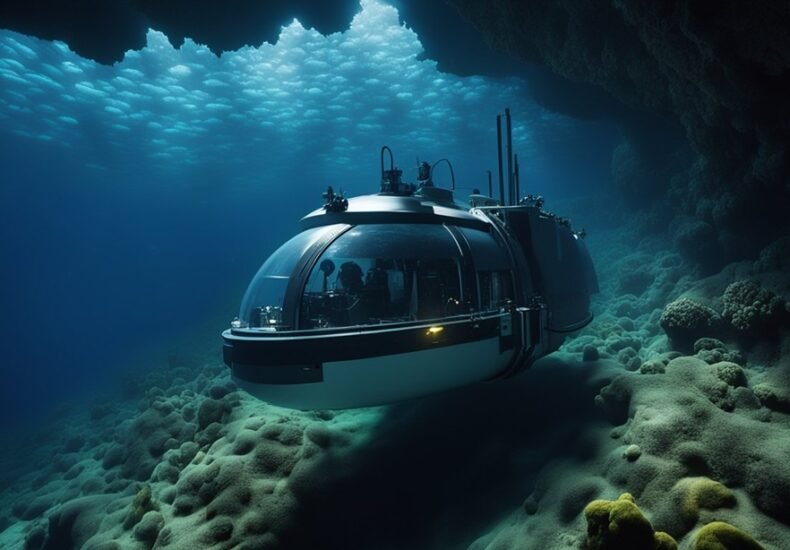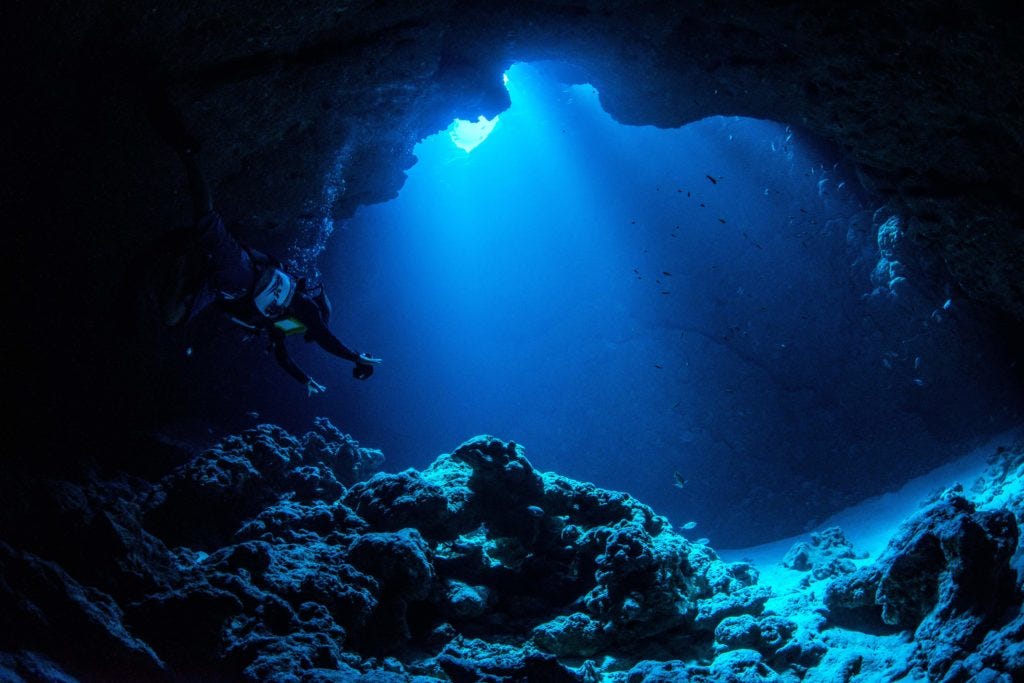
Unveiling the Depths: Discovering the Mysteries of the Mariana Trench
When we look up at the night sky, we often marvel at the stars and dream of galaxies far away. Yet, some of the most mysterious and awe-inspiring places are not above us—they’re deep beneath the ocean’s surface. Among them, the Mariana Trench reigns as the deepest and most enigmatic frontier on Earth. Often called the Earth’s final frontier, it is a place so deep, so dark, and so unexplored that much of it remains cloaked in mystery. But what truly lies beneath? Embark with us on a journey into the breathtaking depths and secrets of the Mariana Trench.

The Mariana Trench: A Glimpse Into the Deep
Located in the western Pacific Ocean, the Mariana Trench stretches over 1,500 miles (2,550 kilometers) and reaches a mind-boggling depth of approximately 36,070 feet (10,994 meters) at its deepest point—known as the Challenger Deep. To truly comprehend its depth, picture Mount Everest dropped into the trench—its towering peak would remain submerged more than a mile below the ocean’s surface.
This crescent-shaped scar in the Earth’s crust was formed by the subduction of the Pacific tectonic plate beneath the smaller Mariana Plate, making it one of the most geologically active regions in the world.
Why Is the Mariana Trench So Fascinating?
The Mariana Trench draws the fascination of researchers, adventurers, and the general public for a host of compelling reasons:
Unparalleled Depth
The trench is the deepest known part of the world’s oceans, offering a unique opportunity to study extreme pressure environments.
Unexplored Territory
Less than 5% of the world’s oceans have been explored, and the Mariana Trench is one of the least visited areas, making it a treasure trove for discovery.
Alien-like Life Forms
Organisms found here have adapted to intense pressure, complete darkness, and freezing temperatures—conditions reminiscent of those on distant planets.
Scientific Curiosity
Understanding what lies at such depths helps us comprehend more about Earth’s geology, evolution, and even the potential for life beyond our planet.
The History of Exploration
The Mariana Trench first captured the world’s attention in 1960, when Jacques Piccard and Don Walsh descended into the Challenger Deep aboard the Trieste, a deep-diving research submersible. Their descent took nearly five hours, and they spent only 20 minutes at the bottom due to the intense pressure.
It wasn’t until 2012 that another manned expedition reached these depths. Filmmaker James Cameron famously made a solo dive to the bottom in his custom-built submersible, the Deepsea Challenger. His historic trip provided valuable scientific data and captured high-definition video footage from the ocean’s most inaccessible point.
More recently, in 2019, explorer Victor Vescovo made multiple dives in the DSV Limiting Factor, discovering new species and collecting data that continues to reshape our understanding of the deep sea.
Life in the Depths: Creatures of the Trench
Despite the near-freezing temperatures and pressures over 1,000 times greater than at sea level, life exists in the Mariana Trench—and it’s nothing short of extraordinary.
1. Amphipods
Small, shrimp-like creatures called amphipods are among the most common deep-sea dwellers. Some species found in the trench are gigantic compared to their shallow-water cousins.
2. Xenophyophores
These are single-celled organisms that can grow as large as a frisbee. Their presence suggests complex biological processes even in such inhospitable environments.
3. Snailfish
The Mariana snailfish, discovered at a depth of around 26,000 feet, is the deepest living fish ever recorded. It’s translucent and lacks scales—perfectly adapted to high-pressure living.
4. Microbes and Extremophiles
These tiny organisms thrive around hydrothermal vents and in sediments, often feeding on methane or sulfur. Some scientists believe similar life forms could exist beneath the icy crusts of Jupiter’s moon Europa or Saturn’s moon Enceladus.
The Science Behind the Depth
At such extreme depths, the pressure exceeds 16,000 psi—far greater than what humans can tolerate. Any vessel or organism surviving here must withstand this crushing force.
The trench also represents a carbon sink where dead organisms fall and decompose, playing a crucial role in the Earth’s carbon cycle. Additionally, sediments from surrounding areas accumulate in the trench, preserving records of past earthquakes, tsunamis, and even climatic changes.
Mysteries Still Unsolved
Despite increasing interest and exploration, many aspects of the Mariana Trench remain unknown.
How vast and diverse is the web of life hidden within the depths of the trench?
Each expedition uncovers new species, suggesting that the trench may host life forms still unimaginable to science.
Can the trench offer clues about Earth’s past—and its future?
The sediment layers at the bottom serve as a historical archive of the planet’s tectonic and climatic shifts.
What role does the trench play in geohazards?
Given its tectonic activity, studying the trench could help scientists better predict earthquakes and tsunamis in the Pacific region.
Technological Marvels: How We Explore the Trench
Exploring the trench requires state-of-the-art technology. Here are some of the tools used:
ROVs (Remotely Operated Vehicles): These are uncrewed, camera-equipped robots controlled from a ship. They can operate for long periods and gather samples and footage.
AUVs (Autonomous Underwater Vehicles): These are pre-programmed to survey specific areas, gathering sonar data, mapping terrain, and detecting anomalies.
Manned Submersibles: Rare and expensive, these vessels like the DSV Limiting Factor allow humans to directly observe deep-sea environments.
Environmental Concerns: A Fragile Ecosystem
The Mariana Trench is not untouched by the effects of human influence. Shocking discoveries of plastic waste and toxic pollutants even at these depths have highlighted the far-reaching effects of pollution. Scientists have found microplastics in amphipods and heavy metals in sediments, raising alarms about the health of deep-sea ecosystems.
Furthermore, with increasing interest in deep-sea mining for minerals like cobalt and rare earth elements, there’s concern about disturbing these delicate habitats before fully understanding them.
Cultural and Philosophical Reflections
Throughout history, the deep ocean has inspired myths, legends, and metaphors for the unknown. The Mariana Trench, with its darkness and depth, often symbolizes both the fear and fascination of the unexplored.
In literature and film, it’s been depicted as a portal to other worlds or a hiding place for ancient monsters. In a more philosophical sense, it reminds us how little we truly know about our own planet.
Could the Trench Unlock the Future?
Beyond its mysteries, the trench may hold keys to future innovations:
Biotechnology: Enzymes from extremophiles could revolutionize medicine, industrial processing, and environmental cleanup.
Space Exploration Models: Studying how life survives in the trench helps astrobiologists design missions to search for life in the extreme environments of other planets.
Climate Change Insights: By analyzing ancient sediments, scientists can better model Earth’s past and future climate behavior.

Conclusion: A Journey Just Beginning
The Mariana Trench is more than a vast chasm in the ocean floor; it serves as a gateway to Earth’s most secluded and mysterious depths. Its exploration embodies the spirit of discovery and the pursuit of knowledge, urging us to look inward into the planet even as we reach outward toward the stars.
As technology advances and curiosity grows, the trench promises to yield even more astonishing revelations. From alien-like creatures to groundbreaking scientific discoveries, the Mariana Trench is a reminder that what lies beneath may be just as thrilling—and important—as what lies beyond. Read more
You may also like
Archives
Calendar
| M | T | W | T | F | S | S |
|---|---|---|---|---|---|---|
| 1 | 2 | 3 | 4 | 5 | ||
| 6 | 7 | 8 | 9 | 10 | 11 | 12 |
| 13 | 14 | 15 | 16 | 17 | 18 | 19 |
| 20 | 21 | 22 | 23 | 24 | 25 | 26 |
| 27 | 28 | 29 | 30 | 31 | ||
Leave a Reply